Diversity shapes Lower Saxony, Crabs and fish on the North Sea coast, fruit in the Altes Land, ham in the Ammerland, kale in the Oldenburger Land, Heidschnucken meat in the Lüneburg Heath, Brunswick sausage, Einbecker beer and Harz cheese. Everywhere, however, people like to eat potatoes and drink grain.
See also Eating and drinking in East Frisia

dishes
- Is very popular sour meat, cold meat in brawn, with fried potatoes and tartar sauce and is offered in almost all restaurants with local cuisine
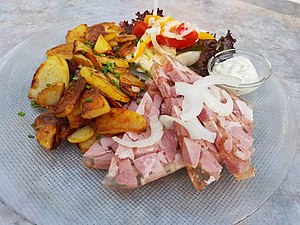
Sour meat with fried potatoes and tartar sauce
- Click (Hackewack, Hackgrütze, in the Hanover area also Calenberger Pfannenschlag) is a specialty in some regions of Lower Saxony. It is a grützwurst made from oat groats, pork belly, pork head, rind, liver, broth, lard, bacon, onions, herbs, seasoned with salt, allspice and pepper, although the recipes vary. The grützwurst is fried with fried or boiled potatoes and cucumber, sweet and sour pumpkin, sauerkraut, applesauce and beetroot or eaten cold or warm on wholemeal bread.
- Knipp with crispy fried slices of Bag sausage (Blood sausage with grits, in Oldenburg, Ammerland and Friesland too Ball of blood called) is Low German as Knipp and Büddelwurst (in Ammerland and Oldenburg as Hackgrütt and Bloodballen) designated .
Knipp raw

Knipp seared with fried potatoes
- In the Lueneburg Heath there are lots of dishes with Heidschnucken-Meat (an ancient breed of sheep). They range from roasts to goulash and sausages.
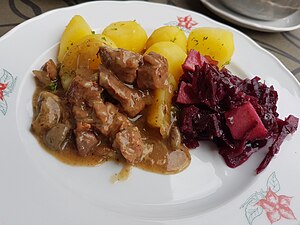
Heidschnuck goulash with heather potatoes and apple red cabbage

Heidjer Knipp made from Heidschnuckenfleisch

Heidschnucken sausages
- Brown cabbage with Bregenwurst comes on the table after the first frost. The vegetable is a subspecies of kale and is used in the Braunschweiger Land Called brown cabbage because it turns brown when cooked. Bregenwurs is a raw or lightly smoked sausage. Potatoes are also eaten.
- Hanoverian tongue ragout consists of beef tongue, meatballs, mushrooms and small sausages in a spicy sauce.
- In the Cellar roulade it is a raw roulade made from well hung beef with a secret mixture of spices, mustard, bacon and onions. You can also eat bread and butter or fried potatoes.
- Buckwheat pancakes are eaten sweet with beet syrup and cranberries or savory with salmon and salad. There are a multitude of possibilities.
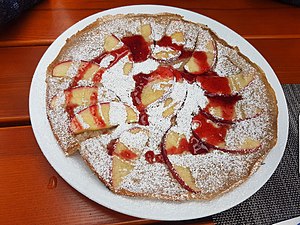
Buckwheat pancakes with apple wedges and cinnamon
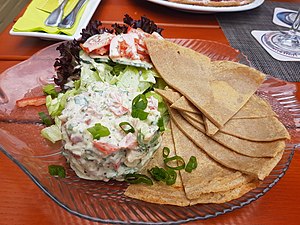
Buckwheat pancakes with salmon tartare
Soups
- A particular specialty in Land Hadeln is the Hadelner wedding soup.
- The Altländer apple soup is cooked from apples and raisins and refined with vanilla and cinnamon.

Hadler wedding soup
fish
Plaice, flounder, herring and mackerel are popular near the coast. Trout and eel are popular inland. Eel is a specialty around the Steinhuder Meer and Zwischenahner Meer.
- Eels have been caught in the Zwischenahner Meer for centuries. They are smoked and as Smoort eel sold. The eels are eaten by hand.
- The Stint (Latin Osmerus eperlanus) belongs to the same family as salmon and sea trout. Like its big siblings, the smelt moves up the Elbe for a couple of weeks from the end of February to April, depending on the water temperature, during spawning time, a festival for fish lovers. The fish is usually 15 to 18, a maximum of 30 centimeters long. Connoisseurs know that the smelt only tastes good if it is not older than a day, you should be able to tell with your nose, it has a slight cucumber scent.
- The fish are gutted and the head removed. Before roasting, they are salted and then turned in rye flour. The smelt is traditionally eaten with warm bacon and potato salad. During the smelt season, the specialty is in restaurants on the Elbe from the mouth up over Hamburg to around Luneburg offered.
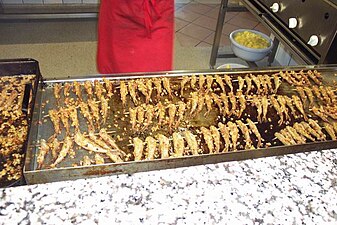
Stint
Fish rolls are popular on the coast, as bismarck, matjes, salmon, fish rolls, smoked fish rolls or something else. They are not only available at the takeaway, they are sold in restaurants. The prices are between € 2.00 and € 3.00, depending on the version. Unlike in other parts of Germany, almost all fish rolls are provided with tartar sauce, or asked whether you want tartar sauce on your roll.
Smoked salmon with onions
Crispy fillet with tartar sauce and onions
Side dishes
- The most popular side dishes are Potatoes, they are eaten in different variations, but mainly as boiled or fried potatoes.
- Kale is a typical winter vegetable. In many parts of Lower Saxony and Schleswig-Holstein, it is a real cult to go on a cabbage ride with clubs, companies and other groups in the autumn and winter months. A typical dish is cabbage with Pee, a smoked grützwurst.

Kale with boiled sausage, pork cheek, smoked pork and sweet (slightly caramelized) fried potatoes

Kale with pee, boiled sausage, smoked pork and bacon

Kale with pee
- A specialty is that Canned cabbage, or also called the "beach trident". A herbaceous plant that resembles chives. It can only be picked by locals, as it is on the Red List of endangered plant species. Cabbage may only be used by the owner of the Wremer Restaurants "Zur Börse" are served to guests.

Cabbage
Pastries
- buckwheat Cake is typical in the Lueneburg Heath. The sponge bases are baked from buckwheat flour and then coated with cream and cranberry jam. The finished cake is decorated with chocolate flakes.
- Uhlen un Apen (Owls and monkeys) are a sweet sand dough pastry in the Braunschweiger Land that goes back to a legend about Till Eulenspiegel.
- Bentheimer mops are a local pastry specialty in the County of Bentheim.

buckwheat Cake

Bentheimer mops
loaf
- Barley bread is a rye bread or mixed rye bread made from sourdough with added yeast. The two-stage fermentation and baking process is special. The block shape of the loaves is created in the proofing basket. Shortly before baking, the loaves are scorched under an open gas flame (tarred, therefore the name). Then the loaves of bread are baked close together. The sides therefore remain soft and the bread has a strong crust on top. Characteristic is the dark mottling of the crust, which shines nicely when coated with a saline solution.
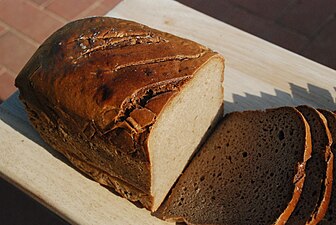
Barley bread
Sweets
- The white and yellow is also a specialty Welfenspeise according to the colors of the noble house of the Guelphs. It is a two-layer dessert, a white milk-vanilla cream with egg white foam, on which, after cooling, a yellow layer of wine cream made from beaten egg yolk, white wine and lemon juice is added.
ingredients
- Buckwheat is the traditional grain of the heather with a particularly low nutritional requirement. It was a staple food well into the 19th century and is still eaten today.
- Ammerland ham is widely known. It has to mature for at least 6 months, is often served with asparagus and is often eaten with black bread.
- The Brunswick Mumme was the export hit in the Middle Ages Brunswick. The viscous strong beer had a long shelf life due to its high alcohol and sugar content and was therefore sold all over the world as provisions for seafaring. With its vitamins and high nutritional value, it contributed to the nourishment of seafarers and also protected against scurvy. In the 18th century, alcohol was then abandoned and the thick malt extract was created, which today is mainly used to refine food and drinks. The Mumme can be mixed with water, milk, tea and beer, for example, or refine sauces, sausage, cheese, cakes, and there are even cookbooks on the subject. The Mumme is offered in some grocery stores in and around Braunschweig and it is also used in some restaurants. You can buy the Mumme at the tourist information office, Kleine Burg 14, for example, and there are also guided tours on the subject.
- harzer cheese or Harz roller is a sour milk cheese made from cow's milk. It contains only 1% fat.
Brunswick Mumme

Harz cheese, Harz counter and basket cheese
beverages
- A Lüttje Lage is popular mixed drink in the Hanover region. A special top-fermented Lüttje-Lagen draft beer (5 cl with 3% alcohol by volume) and a grain brandy (1 cl with 32% alcohol by volume) are mixed together while drinking. Associated with this is a special traditional way of drinking. The small, low beer glass is taken between thumb and forefinger. The middle and ring fingers of the same hand hold the grain glass. When drinking, the glasses come on top of each other so that the grain schnapps can be drunk together with the beer in one go. For the inexperienced, this is a challenge that does not always go well. If you simply pour the schnapps into the beer, you can be sure of laughter.
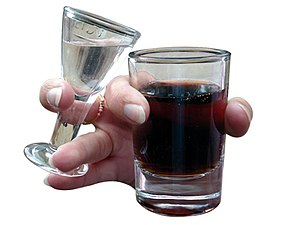
That's how you do it right
beer
- The origin of the bock beer lies in Einbeck. In the Middle Ages, top-fermented beer was brewed and transported as a luxury product over long distances, even as far as Italy. To make it durable for long transport, a heavy, alcohol-rich beer was brewed. The Wittelsbacher court in Munich had the beer delivered from Einbeck until they got the idea of brewing the beer themselves. In 1614, a master brewer from Einbeck was lured away and from then on he brewed Ainpöckisch strong beer in the Hofbräuhaus in Munich. In the course of time the term was used in the Munich dialect Bock beer from it.
Schnapps and liqueurs
- The center of the Grain brandy is Haselünne with three well-known distilleries, Rosche, Berentzen and Heydt. They offer factory tours and tastings.
- A hannoversche The specialty is beet brandy Hanover's Leinewasser
- The world-famous herbal liqueur Jaegermeister date back to Wolfenbüttel. The production can also be visited.
- Danzig Goldwasser is a spice liqueur with an alcohol content of 40 percent by volume and small gold leaf flakes. Originally it was made in Gdansk, today it comes from the Hardenberger Kornbrennerei in Norten-Hardenbergwhere other clears are also made.
Soft drinks
Culinary calendar
Culinary delights are often seasonal. Fruits and vegetables are tastier when they are ripe; meat and fish are also subject to seasonal influences. Every season of the year, festivals are celebrated that have a general theme or focus on certain foods. There are also drinking and eating habits throughout the year that arose from religious traditions such as fasting times.
January
February
- The Smelt season begins
March
- Smelt season
April
- The Smelt season ends
- The Asparagus season starts at the beginning of April, depending on the soil temperature
- Traditionally on April 23rd the Day of the beer celebrated, because on this day in 1516 the German purity law was proclaimed. There are events on the topic of beer in many places (German Brewers Association).
May
- Asparagus season
- May 1st is in EinbeckUr-Bock tapping
- A weekend in the second half is in Nienburg Asparagus market with asparagus meals on the church square and in the city center, asparagus run and asparagus queen's freestyle.
- Friday and Saturday after Ascension are in SteinhudeFischerkreidag. There is a historical court meeting of the fishermen's guild, a peat barge regatta, a fisherman's meal and regional eel specialties.
- Last weekend in May or first weekend in June are in EmdenMatj days. Matjes is offered in many varieties at the fish market. Shanty choirs and live bands provide entertainment, traditional ships can be admired in the inland port and Ratsdelft.
June
- The Asparagus season ends on Midsummer Day, June 24th.
- Dwarsloeper culinary festival, the culinary days of the Wurster North Sea coast with a program full of culinary delights and events. Restaurateurs offer specialties of the local cuisine.
July
- At the beginning of July takes place in Old country the traditional Cherry week instead, in which everything revolves around the cherry.
- In Neustadt am Rübenberge will be in the middle of July in odd years Champagne festival Celebrated in Schloss Landestrost by the Dupres-Kollmeyer Sektkellerei.
- Greatest Labskausessen the world, takes place annually on the last Saturday in July in downtown Wilhelmshaven instead, the record is 10,612 servings.
- On the last Sunday in the Moor Museum in Geeste the Buckwheat Blossom Festival celebrated. There are buckwheat pancakes and much more.
August
- From August to November there is the apple harvest during the Altländer Apple Days in the old country.
September
- Altländer Apple Days
- The second Sunday in Uslar the Pekermarkt hosted. Peker is a potato dish with ground meat, onions and butter.
October
- Altländer Apple Days
November
- Altländer Apple Days
- Kale season
December
literature
Recipes
If you want to enjoy Palatinate cuisine at home, you will find the appropriate recipes in Koch Wiki under Category: Lower Saxony cuisine. Have fun cooking at home.























